 Oh boy, only four more sleeps until, once again, I'll be attending The Reubens, the annual awards ceremony of the National Cartoonists Society (of which I am a proud member). As in previous years, I'm going to use this week as an opportunity to showcase some of the Luminaries of the NCS. Let's begin with a look at one of the true titans of the comic strip form, Al Capp.
Oh boy, only four more sleeps until, once again, I'll be attending The Reubens, the annual awards ceremony of the National Cartoonists Society (of which I am a proud member). As in previous years, I'm going to use this week as an opportunity to showcase some of the Luminaries of the NCS. Let's begin with a look at one of the true titans of the comic strip form, Al Capp.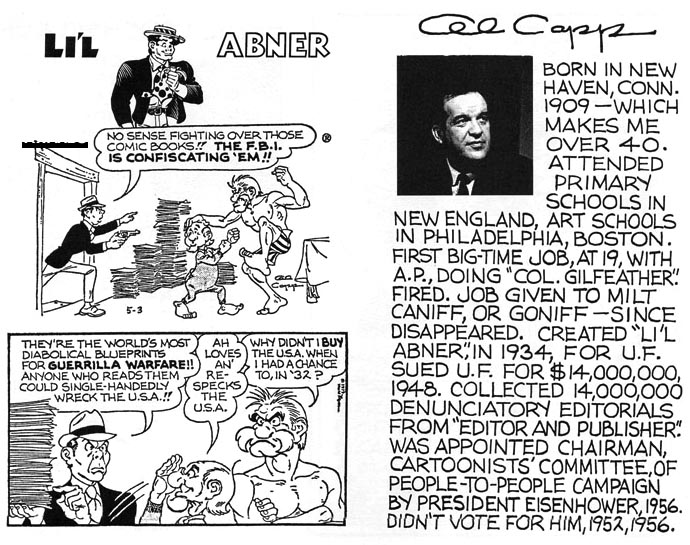
My friend Tom Sawyer (whose career was the subject of a week of posts here on TI in 2008) has graciously agreed to share with us an excerpt from his memoirs in which Tom describes his experience working for Al Capp in the early '60s as one of his assistants. Many thanks, Tom!
Excerpted from Thomas B. Sawyer's memoirs:
One morning in my studio I received an unexpected phone call that turned out to be the catalyst for the next dramatic changes in my life. The caller was the legendary cartoonist/humorist Al Capp, creator of the phenomenally successful comic-strip, Li’l Abner, the influence of which had been felt all over America for many years.
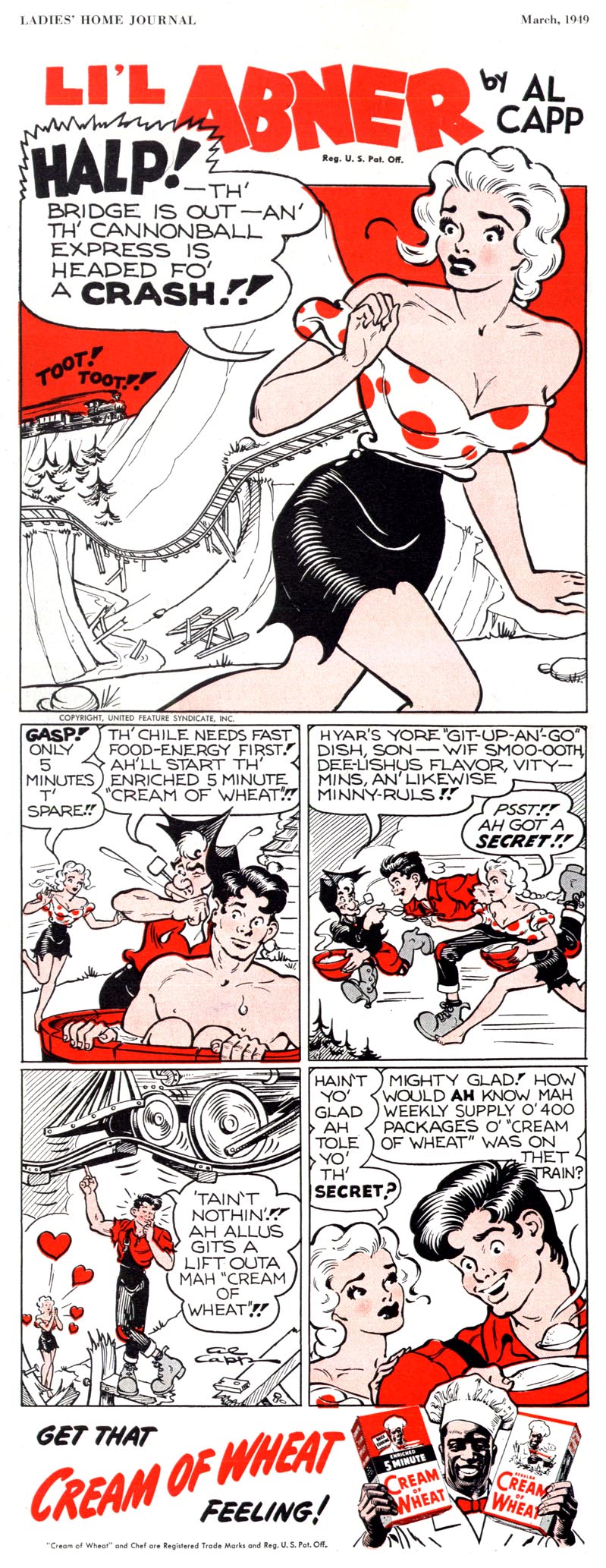
Though I had met Al once or twice at cartoonist functions, we didn’t ‘know’ each other. But having heard him on radio and on TV interviews, I immediately recognized that garrulous voice and singular, bigger-than-life laugh.
Al explained that he had this problem. His inker/assistant-artist of 20-some years – the guy who penciled all the realistic (non-cartoon-ish) figures – had had a stroke, and Capp was desperate. He explained that he’d called around to the likes of Stan Drake and others for the name of an artist who could do this sort of work, and I was at the top of everyone’s list. What Al needed was for me to spend every other week at his studio in Boston for at least the next few months, where I’d be provided with a bed and food.

I thanked Al, said I was flattered – which I was – but no, I couldn’t. I told him the truth, that I was up to my eyeballs in work. I wasn’t trying to be cute – though it was not a gig that interested me. To avoid insulting him, I did not spell out that I definitely had no intention of serving as assistant to anyone. Even Al Capp. Further, doing alternate weeks in Boston was even less appealing. Outside my studio window the trees wore that lovely green haze of new leaves that signified the end of another endless New England winter, and almost the last thing I wanted to do at that moment was leave town.
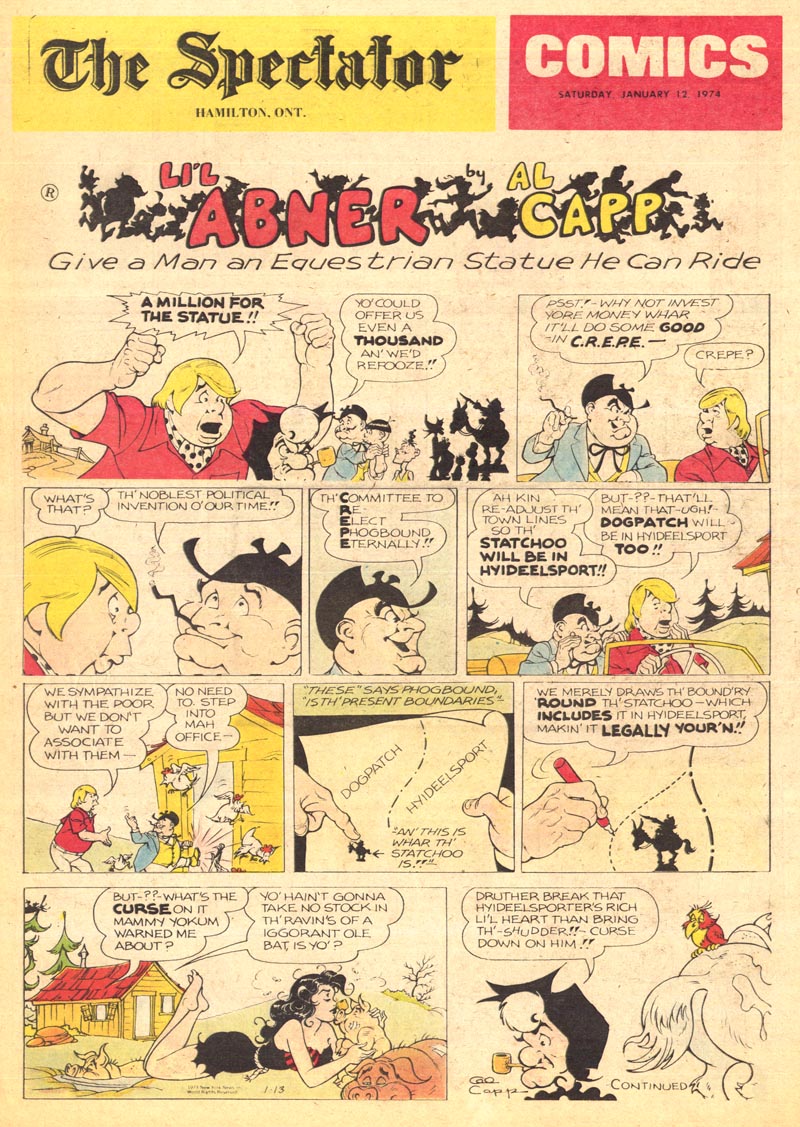
But Al refused to let go. As if reading my mind he did a pitch for his studio, a lovely, charming converted carriage-house at the foot of Beacon Hill, with the best of Old Boston – Charles Street, the river, the Common and the Public Gardens only steps away. Again I said no, this time adding what I figured would be my closer: that my price was too high. He couldn’t afford me.

And damned if he didn’t call my bluff, demanding to know how much it would cost, how much I would require. I did some rapid arithmetic, added 50% to my then-weekly average, and threw the number at him, confident that I was off the hook.
Wrong.
Al said okay, fine, can you be here tomorrow?
I took the train that first time. His studio was indeed terrific, with comfortable space for Al, his lettering man, his aging cartoon-character penciler, and for me. Al and I hit it off immediately, which was confirmed for me a couple of days later when, with Al absent, his lettering guy confessed that a half-hour after my arrival, while I made my first trip to the bathroom, Capp had turned to the others and guffawed: “Hah! That’s me, 30 years ago.”
Not quite, but hey…

… Al Capp turned out to be one very entertaining guy. As expected, major funny, brilliantly politically aware, and commercially, brilliant. This last evidenced, especially, in that Al, a lifelong Liberal, and JFK fan, who lived in Cambridge and socialized with the Kennedys, the Schlesingers and others of the Best and the Brightest, had discovered that on the lecture-circuit at that time there was no longer any money in being a Leftie. So Al Capp became, arbitrarily, an articulate and of course witty spokesperson for the far-Right. He never believed a word of what he said, but the demand for his services as a speaker increased dramatically, and his fees jumped from $3,000 to $10,000.
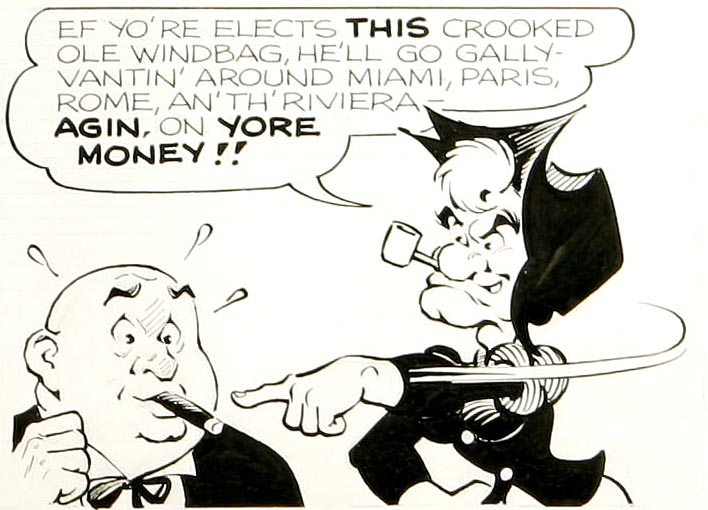
Al was unique in other ways. Famous for, in addition to his comic-strip, his wooden leg (as a boy in Bridgeport, Connecticut he’d fallen off the back of a truck and been run over by a trolley-car), about which he joked…
…A word about how Al produced his justly renowned comic-strip. He wrote all of it, often while talking – and guffawing at his own jokes. In addition to a lettering-man, there was another long-term assistant, Andy. Italian-American, late-sixtyish, permanently depressed, a bachelor whose social life seemed to consist of nightly visits to the local dog track, where he regularly gambled and lost, Andy penciled the strip’s humorous, cartoony figures. After I drew the more realistic ones, mainly the voluptuous girls, I inked all of it – except for the faces.

Al did those – with a very personal, singularly sensitive line that nobody could have imitated.

He truly loved the characters he’d created, was protective of them, and would not tolerate insults to any, even the broadest of them, such as the Schmoos...
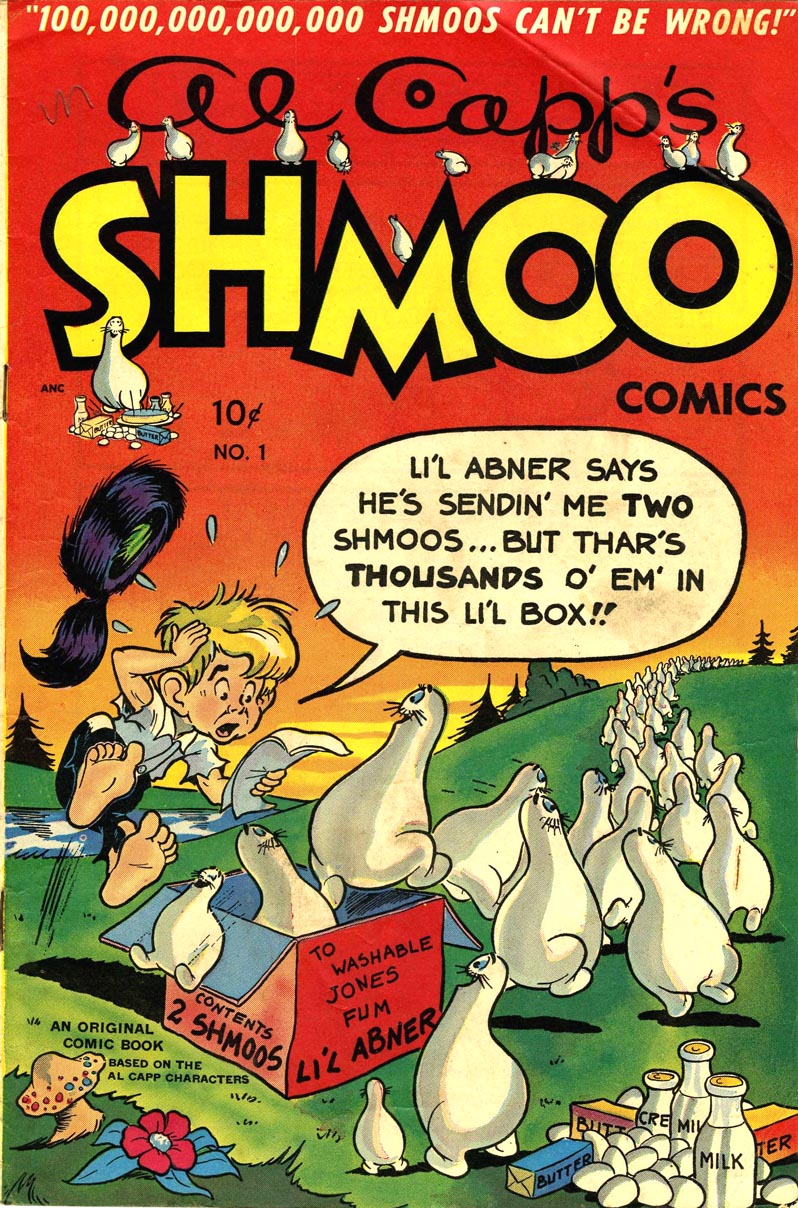
... and, especially the strip’s beautiful blonde, always briefly-clad heroine, Daisy May. Al took offense, for instance – to my surprise, though I should have known better – when I confessed that as a teenager I had, for my own amusement, written and drawn a brief pornographic version of Li’l Abner, in which Abner and Daisy Mae had sex.
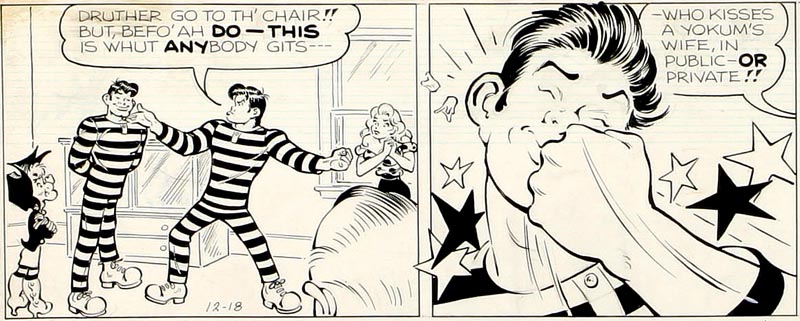
And of course – especially while Al was present – the studio was filled with more or less constant, funny chatter, Andy’s wry one-liners and responses being uniformly as dark as his life-view, which was nailed for me by the calendar he kept push-pinned to the upper corner of his drawing table. One of those month-per-page affairs, it was laid out with a roughly one-inch square box for each day. And every morning, upon arrival, Andy’s first move after seating himself was to grab a soft pencil and, carefully staying within the borders, completely blacken that day’s box. By the end of a month, the entire page was black.

Though the work I did on Li’l Abner wasn’t challenging, it was turning out to be a relaxed, pleasant gig, highlighted in that first week by a couple of late-evening dinner excursions with Capp, just the two of us – and the great, entertaining conversations that went with them.

The first of these was memorably initiated by his suggestion that we go out and grab some Chinese food: “…When you’re middle-aged and Jewish and have a wooden leg, y’need a lotta Chinese food.”
* Many thanks to Tom Sawyer for sharing this wonderful excerpt from his memoirs with us.
The text of today's post is Copyright © 2010 by Tom Sawyer Productions, Inc.
* Thanks also to Heritage Auctions for allowing me to use several scans from their archives to illustrate this post.
*Also, Terry Beatty has some amazing Al Capp/ Li'l Abner rarities on his blog! Go take a look here, here and here -- thanks Terry!
My Al Capp Flickr set.
Hi Leif,
ReplyDeleteThis piece about Capp is great! I've been reading the strips that (the sadly, recently deceased) Frank Frazetta drew in his years as Al's "ghost" and it truly is one of the best strips of all time.
As you probably know, Frazetta left the studio after a dispute with Al Capp that was ironically similar to the earlier fight that erupted between Capp and Ham Fisher when Capp was Fisher's assistant. The Frazetta/Capp split wasn't quite as acrimonious as the Fisher/Capp feud though; the latter ending in Fisher's suicide after he was caught trying to forge pornographic drawings and passing them off as Capp's work!
Just one of many almost unbelievable stories about the golden age of cartooning.
Anyhow, thanks to you and Mr. Sawyer for a great installment of TI!
Huw Evans
EYECATCHER Graphics & Design
Thanks for that additional info, Huw! I came a cross some scans of those Capp/Frazetta originals in my research for this post -- I have to admit that, knowing almost nothing about Al Capp, I was very curious to learn more about his relationship with Frazetta. Thanks for filling in some of the holes. the golden age of cartooning was indeed filled with some jaw-dropping stories. Those cartoonists were the real characters!
ReplyDeleteThe thing that makes my jaw drop is the unbelievable money Capp was making for this production.
ReplyDeleteI havent seen much of this strip, but what I have seen I don't really 'get'.
Obviously it was a product of it's time. but then so was Pogo, and that still works for me.
I can now see why every cartoonist dreamt of becoming syndicated.
Capp justifiable earned his reputation and, like Mark Twain, created pure Americana. Like W. Disney, C. Schulz, and W. Kelly, Al discovered how lucrative advertising and marketing could be. By owning his strip the majority of his income came through franchise. Al was the clique pioneer and genius.
ReplyDeleteThanks for this enlightening excerpt! I have always had mixed feelings about the strip and Mr. Capp, oddly fascinated and repulsed at the same time. Just old enough to remember it in it's waning days as a genuine national obsession... It is very interesting to hear Mr. Sawyer's take on Capp's conversion to conservatism!
ReplyDeleteHi Leif,
ReplyDeleteGreat stuff as always. Over at the Comics Journal message board Jesse Hamm brought up an interesting point regarding Frazetta. Given that Frazetta quit around the time Tom Sawyer started, and they both did the same job, does Mr. Sawyer know the name of the artist he replaced who had the stroke? There's some question as to whether or not Capp was being honest about the reason he needed a new assistant.
Steve;
ReplyDeleteI forwarded your comment to Tom -- here is his reply:
Re: the Steve Hogan/Jesse Hamm comment, the assistant who had the stroke was a real guy whose name I do not recall, but he'd been with Al for about 25 years, and was mentioned by name by Andy (he of the blacked-out calendar) and Al several times while I was working with them.
Delighted that the piece about Al has drawn so much attention. I forwarded it to a number of friends, and have gotten some wonderful responses. And BTW, when Capp was doing his phony-conservative number, it wasn't just speaking-gigs: for a time he also had a radio talk-show on the topic.
Thanks for the response, and all the great work on the strip!
ReplyDeleteIn the Comics Journal message board, I'd scanned and posted this Dec. 1969 "Saga" interview with Capp about "those revolting students": http://archives.tcj.com/messboard/viewtopic.php?t=7333 .
ReplyDeleteIn the "Comics-style magazine ads" thread there, I posted two scans of "Lil' Abner" Cream of Wheat ads from 1940 magazines at http://archives.tcj.com/messboard/viewtopic.php?t=3949&postdays=0&postorder=asc&start=40 and http://archives.tcj.com/messboard/viewtopic.php?t=3949&postdays=0&postorder=asc&start=60 . Could Tom Sawyer have been involved in creating these too?
Re those Schmoos, Denis Kitchen tells how....
---------------------
Cartoonist Al Capp was already world-famous and a millionaire in 1948 when he introduced an armless pear-shaped character called the Shmoo into his daily "Li'l Abner" strip...
Virtually overnight, -as a LIFE magazine headline put it- the "U.S. Becomes Shmoo-struck!" The character's remarkable success catapulted Capp to an all-new level of wealth and fame. It is difficult, fifty years later, to convey to new generations the profound impact the lovable Shmoo had on American culture. The following facts may help . . .
• Close to one hundred licensed Shmoo products from seventy-five different manufacturers were produced in less than a year, some of which sold five million units each...
• The Shmoo was an unprecedented media and merchandise phenomenon (1948-52). America went Shmoo-crazy. There had never previously been anything like it...
• Forty million people read the original 1948 Shmoo story (combined circulation of the 500+ daily newspapers carrying "Li'l Abner"). And Capp's already considerable readership roughly doubled following the overwhelming success of the Shmoo.
...• During its first year Shmoo merchandise generated over $25,000,000 in sales (in 1948 dollars)!
---------------------
Much more at http://www.deniskitchen.com .../docs/new_shmoofacts.html
Thanks so much for posting this, and for the great images. Fascinating read...
ReplyDeleteCapp's work finally seems to be going through a well-deserved renaissance, after years of distraction over his politics and personality.
I'm a liberal, too, folks, but I don't think that should be a prerequisite for having one's work appreciated. Here's to a world of free speech for liberal talk radio and conservative comic strips alike.
Count me among those who regard "Fearless Fosdick" as the father of MAD magazine.
Can't wait to get my hands on this book...thanks again for bringing it to our attention. I'll pass this link around for sure!